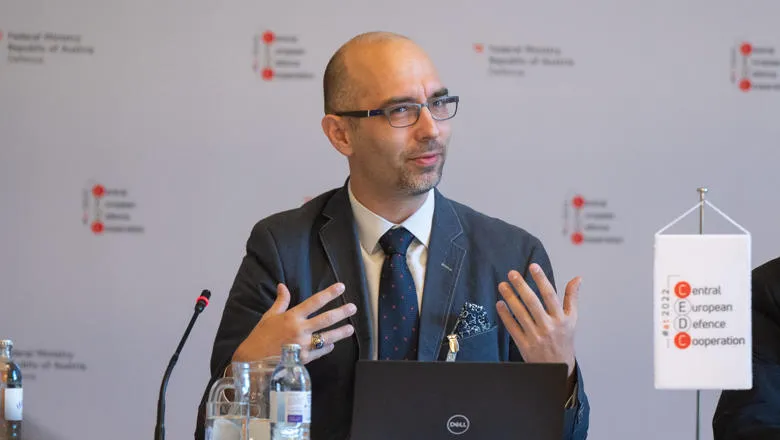The main issue in past strategic foresight work has been that military organisations tend to focus very narrow interpretation of the future. They look for what is the most likely situation to occur. Effective strategic foresight teaches you that you need to do much more than that: you need to consider multiple different scenarios and conduct deeper analysis of the possible effect. We shouldn’t focus on just one future.”
Dr Bence Nemeth, co-author of the research paper
26 May 2025
How a King's academic's research is changing NATO's approach to planning for the future
NATO has featured a paper co-authored by Dr Bence Nemeth, Senior Lecturer in the Defence Studies Department, as the key case study in a new handbook advising all its institutions and member states on how to carry out strategic foresight activities.

The handbook, Future Strategic Environment Assessment: Framework for Analysis, dedicates a page to the insights of the research paper and uses it to highlight best practice when training alliance members in strategic foresight.
Strategic foresight is the process of estimating the likelihood and impact of future scenarios and challenges so they can be anticipated, planned for and mitigated as necessary. The paper was a project Dr Nemeth carried out as part of his MBA supervised by Nicholas Dew and Mie Augier at the US Naval Postgraduate School in Monterey, California. In it, he analysed a Hungarian Ministry of Defence foresight study from 2013-14 which was designed to identify potential threats and opportunities in the 2015-30 period. It considers where the ministry’s predictions correctly identified emerging trends in Russian foreign policy, as well as where it accurately anticipated developments in European migration, but also where its methodology fell short of success in either domain. It provides clear conclusions and recommendations regarding what is needed to make future strategic foresight effective for military bodies.
The paper explains in a conceptual way how strategic foresight works in practice. It directly informs NATO’s guidance on how alliance members should approach future challenges, conduct foresight exercises and plan their defence strategies.
NATO using this research in its official teaching is an example of how academic research from King’s is actively shaping and influencing real-world defence policy.
Why the Hungarian Ministry of Defence?
Dr Nemeth was working for the Hungarian MoD in 2013 and led the strategic foresight exercise that he has now gone on to review. The paper was written in 2018, as part of his MBA in the US, when Nemeth, Dew and Augier conducted a “lessons learned” project to examine the mixed results of the Hungarian exercise. They found that its predicted outcomes were generally accurate in nature but their timing and anticipated impact were not. For example, the Strategic Analysis Group (SAG) that carried out the work foresaw future Russian military aggression but did not anticipate that it would occur in Ukraine as early as 2014. It also correctly anticipated that a European migration crisis would follow but Dr Nemeth recalls in the paper that “informally they did not believe that migration would have a serious impact on the Hungarian defense [sic] sector.” Dr Nemeth and his colleagues sought to discover where the disconnect lay between the predicted results and their actual effects and to leverage the findings into recommendations for future strategic foresight processes.
How do you measure strategic foresight?
The paper cites established frameworks that can be used both to conduct and to evaluate strategic foresight. The generic framework created by Joseph Voros can be used to “diagnose” a foresight activity that wasn’t 100% successful – like that of the Hungarian MoD – into one of three possible categories: reactive, shallow or shallow/narrow. The team concluded that the Hungarian MoD’s approach was shallow because it omitted two of the key stages of strategic foresight: it didn’t “interpret” events to understand them beyond their surface-level appearance and it didn’t “prospect” to theorise as to what might happen rather than assume that the previous trend will continue.
Having made the diagnosis, the team then tried to discover why the Hungarian MoD had missed the interpretation and prospecting phases. They turned to the work of Rafael Popper, a leading foresight analyst who created a method of classifying foresight methods into four categories. Popper’s research demonstrates that the foresight methods used tend to illustrate an organisation’s beliefs and culture, which can adversely impact the accuracy and effectiveness of foresight predictions. Applying Popper’s classification framework to the Hungarian SAG’s methods showed that they fell into only two of the four possible categories, which made it incomplete.
This demonstration of how foresight methods can be analysed and evaluated is what made the case study so pertinent to NATO’s guidance.
Making a lasting change to NATO guidance and training
Historically, the military has used intelligence methods to anticipate future outcomes. This relies on making predictions based on facts. Dr Nemeth offers an alternative point of view: “Foresight says you don’t necessarily need the best facts – you need to broaden the horizon of the organisation. Intelligence methods have polluted the foresight methods used in military organisations, as in the case of the Hungarian MoD.”
Dr Nemeth’s case study appearing in the NATO manual on strategic foresight is the first time this strength of rationale has been used to support this type of guidance and training. It is the only case study of its sort that will be used to guide all 32 member countries from intelligence-based predictions to effective strategic foresight approaches.
The original intention for this article was to create a kind of idea-busting framework of where foresight models can either go badly or in the right way. Its appearance in the NATO manual really vindicates our research. It’s about more than just writing academic papers – now it’s something that organisations throughout the Translatlantic region will use and are already using. It’s a very good feeling that we’re having a real impact.”
Dr Bence Nemeth, co-author of the research paper
Bence Nemeth is a Senior Lecturer in Defence Studies. He primarily teaches British and international military officers at the Defence Academy of the UK. Strategic foresight is included in his Intelligence in Conflict module, part of the online MA in International Affairs.
Read the full research paper here.

